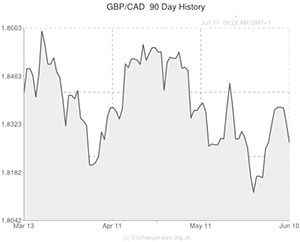
Although Sterling is being supported by the expectation that today’s UK manufacturing and industrial reports will print positively, the GBP to CAD exchange rate still began the local session in a softer position.
At the close of last week the appeal of the Canadian Dollar was dented by the news that Canada’s unemployment rate unexpectedly climbed in May.
Although the nation’s economy added more positions that anticipated last month (25,800 versus expectations for an increase of 21,500) the Canadian participation rate held at 66.1 – causing the jobless rate to rise from 6.9 per cent to 7 per cent. The increase in employment was also due to a surge in part-time work rather than a sustainable gain in full-time positions.
The Canadian Dollar declined against peers like the Pound, Euro and US Dollar after the data was released.
The report offered a sharp contrast to the US employment figures. The US non-farm payrolls figure came in above estimated levels, with the US unemployment rate holding at 6.3 per cent rather than rising to 6.4 per cent as economists predicted.
While the Federal Reserve is currently in the process of tapering its quantitative easing programme (and is edging ever closer to issuing an interest rate increase) the patchy nature of Canadian economic data means that the Bank of Canada is adopting a far more cautious approach to fiscal policy.
In recent months the central bank has restated its intention of keeping interest rates on hold for the time being, and it is even possible that a rate cut could be on the cards if Canada’s economic performance doesn’t step up a gear.
However, as the North American session progressed on Monday the ‘Loonie’ advanced on the Pound as Canadian housing starts were shown to have climbed to a seven-month high in May.
Last month builders started working on a seasonally adjusted 198,324 homes, year-on-year – smashing estimates for a reading of 185,000. This followed an annualised increase of 198,324 in April, a figure which had been positively revised from 196,687.
Over the first three months of 2014 starts averaged at 174,984.
The result was indicative of the more general economic rebound inspired by the end of a particularly harsh winter.
In the view of Scotiabank Economic’s Derek Holt; ‘After what were probably weather related interruptions over Q1 during a worse than average winter for many regions of the country, the average pace of homebuilding activity is on the mend. Housing should therefore contribute positively to [Q2] GDP growth’.
As it stands the GBP to CAD exchange rate is trading in the region of 1.8317, up from a low of 1.8300.
Later today additional movement in the Pound to Canadian Dollar exchange rate could be caused by the UK’s industrial/manufacturing output reports. If they show the 0.4 per cent monthly gains projected the Pound could recoup losses against the ‘Loonie’.
Over the next few days the Canadian data to be aware of includes the nation’s new housing price index and capacity utilisation rate as well as manufacturing sales and shipments figures.
Global economic developments (including the influential advance US retail sales figure) could also act as a catalyst for Canadian Dollar movement.
Updated 09:35 GMT – 11/06/2014
The Pound to Canadian Dollar exchange rate was 0.2 per cent higher after the release of UK employment data.
This week the Canadian Dollar has been deriving support from a better-than-forecast domestic housing starts report, a risk-on environment and a rally in gold prices.
However, substantially better-than-forecast UK jobs figures helped the Pound recover losses against the ‘Loonie’ on Wednesday.
The British unemployment rate fell from 6.8 per cent to 6.6 per cent in the three months to April, beating the projected figure of 6.7 per cent, as the nation’s economy added a whopping 345,000 positions. However, gains in the GBP to CAD paring were a little limited by the fact that average weekly earnings failed to rise by as much as expected.
Wages were forecast to increase by 1.2 per cent in the three months to April but they only rose by 0.9 per cent.
While there is little in the way of Canadian economic news to be aware of in the hours ahead, investors will be looking ahead to tomorrow’s new housing price index.
Canadian Dollar (CAD) Exchange Rates
[table width=”100%” colwidth=”50|50|50|50|50″ colalign=”left|left|left|left|left”]
Currency, ,Currency,Rate ,
Canadian Dollar, ,Pound Sterling,0.5479,
,Pound Sterling,0.5479,
Canadian Dollar, ,US Dollar,0.9180,
,US Dollar,0.9180,
Canadian Dollar, ,Euro,0.6782,
,Euro,0.6782,
Canadian Dollar, ,Australian Dollar,0.9775,
,Australian Dollar,0.9775,
Canadian Dollar, ,New Zealand Dollar,1.0783,
,New Zealand Dollar,1.0783,
US Dollar, ,Canadian Dollar ,1.0896,
,Canadian Dollar ,1.0896,
Pound Sterling, ,Canadian Dollar,1.8243,
,Canadian Dollar,1.8243,
Euro, ,Canadian Dollar,1.4748,
,Canadian Dollar,1.4748,
Australian Dollar, ,Canadian Dollar,1.0228,
,Canadian Dollar,1.0228,
New Zealand Dollar, ,Canadian Dollar,0.9372,
,Canadian Dollar,0.9372,
[/table]

Comments are closed.